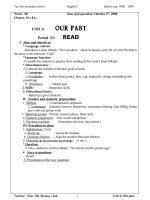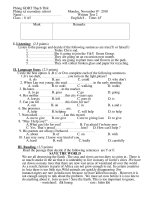anh 8 tuan 23
Bạn đang xem bản rút gọn của tài liệu. Xem và tải ngay bản đầy đủ của tài liệu tại đây (157.79 KB, 10 trang )
<span class='text_page_counter'>(1)</span>Week: 23 Period: 67. Date of planning: 10/01/2017 Date of teaching: 19/01/2017. UNIT 10: RECYCLING LESSON 4: WRITE I. OBJECTIVES: By the end of the lesson, students will be able to write a set of instructions on how to recycle used things, write a set of instructions, using sequencing. II. PREPARATIONS: Book, computer. III. PROCEDURES: TEACHER’S ACTIVITIES. STUDENTS’ ACTIVITIES.
<span class='text_page_counter'>(2)</span> 1. Warm – Up: (5’) - Have Ss play game: Lucky Number 1. What do people do with empty milk bottles? 2. What is compost made from? 3. Lucky number 4. Lucky number 5. What happens to the glass when it is sent to the factores? - Lead to the lesson 2. Pre – Writing: (10’) Activity 1: - Introduce the lesson: There are many things that can be recycled. However, not many of us know how these materials are recycled. In this lesson, we will know how to recycle tea leaves and papers into new items. Do you know how to recycle paper in a traditional way? - Explain some vocabularies: I. New words: + Soak (v): ngâm + Wrap (v): bao bọc, gói + Mix (v) – mixture (n): trộn – hỗn hợp + Dry (v) : phơi khô + Mash (v): nghiền nát + Wire mesh (n): dây điện lưới + Scatter (v): rãi + Tray (n): cái khay - Check vocabulary: “Slap the board” Activity 2: - Ask students to work in groups to guess the order of the actions, using the sequencing: First, then, next, after that, finally ……… 1. Mash the paper by a wooden spoon. 2. Use a wire mesh to pull the mixture out, put it on the cloth and press it down firmly. 3. Soak old newspaper in a bucket overnight. 4. Take the mesh out of the cloth and dry it in the sun. 5. Mix the mashed paper with water. - Get feedback.. - Work in groups.. - Listen - Listen to the teacher.. - Listen, copy down and practice. - Do as directed. - Work in groups 1. First, soak old newspaper in a bucket overnight. 2. Then, mash the paper by a wooden spoon. 3. Next, mix the mashed paper with water. 4. After that, use a wire mesh to pull the mixture out, put it on the cloth and press it down firmly. 5. Finally, take the mesh out of the cloth and dry it in the sun. - Give feedback..
<span class='text_page_counter'>(3)</span> 3. While – Writing: (15’) - Guide: In some areas people burn dry tea leaves to keep mosquitoes away. Make directions on how to prepare the tea leaves by using the pictures and given words in the box. - Ask students to work in groups to write the instruction on how to prepare the tea leaves. - Ask students to give feedback on the board. 1. First, take the used tea leaves from the teapot. 2. Next, scatter the tea leaves on a tray. 3. Then, dry the leaves in the sun.( bad ss) 4. Finally, put the dry leaves in a pot for future use. 4. Post – Writing: (13’) - Ask students to read the text on the page 93 and fill in the verbs. - Ask students to give feedback. 1. use 2. mix 3. place 4. press 5. wrap 6. wait 7. dry 5. Homework: (2’) - Ask Ss to: + Rewrite the instructions on how to prepare the tea leaves. + Prepare Unit 10 – Language focus/ p. 95-97.. - Listen.. - Work in groups.. - Give feedback. - Work in pairs. - Give feedback. - Write assignments.. IV. COMMENTS: ............................................................................................................................................ ............................................................................................................................................ .............................................................................................................................................
<span class='text_page_counter'>(4)</span> Week: 23 Period: 68. Date of preparing: 10/01/2017 Date of teaching: 21/01/2017. UNIT 10: RECYCLING UIT 10: RECYCLING LESSON 5: LANGUAGE FOCUS I. OBJECTIVES: By the end of the lesson, Ss will be able to learn more about passive forms, review structure adjective followed by infinitive. II. PREPARATIONS: Book, poster. computer. III. PROCEDURES: TEACHER’S ACTIVITIES. STUDENTS’ ACTIVITIES.
<span class='text_page_counter'>(5)</span> 1. Warm – Up: (5’) - Have Ss play game: “Pelmanism” infinitive Past participle break built blow made build blown make broken 2. Exercises: (35’) Exercise 1: Passive forms - Review structure: Passive forms Be + Past participe (ed/ 3) - Introduce new structure: * Present simpe tense: (+) S + am / is/ are + Vp.p + (by O). * Past simple tense: (+) S + was/ were + Vp.p + (by O). * Present perfect tense: (+) S + have/ has + been + Vp.p + (by O). * Future simple tense: (+) S + will/ shall + be + Vp.p + (by O). * Subject in direct sentence is opmissed if it is unclear, or unimportant such as I, We, You, They. He, She, It, People, Every (one, body….), Some (one, body….). - Ask Ss to do exercise 1. Read the instructions on how to recycle glass and rewrite the sentences in passive form. - Call some Ss to write the answer on the board. a. The glass is broken into small pieces. b. Then the glass is washed with a detergent liquid. c. The glass pieces are dried completely. d. They are mixed with certain specific chemicals. e. The mixture is melted until it becomes a liquid. f. A long pipe is used. It is dipped into a liquid. Then the liquid is blown into indented shapes. Exercise 2: Passive forms - Introduce: In order to further understand the passive form you do exercise 2. complete the dialogue between Mrs. Kim, a famous inventor and Hai, his assistant. They are talking about the coming invention of a time machine. Use the correct form of the verbs in the brackets. - Ask Ss to complete the dialogue in pairs. - Call some pairs to read the answer.. - Play game... - Review. - Listen and write.. - Do the task. - Write the answer.. - Listen.. - Work in pairs..
<span class='text_page_counter'>(6)</span> + will ………..be started + will be shown + Wil ….be built + will be finished + Will …….be made Exercise 3: Adjective + To - infinitive - Introduce structure: It is + adjective (for sb)+ to – infinitive - Ask Ss to do exercise 3. Use adj and verbs in the box to complete the sentences. - Call some Ss to read the answer. a. difficut to follow b. easy to understand c. hard to believe d. dangerous to go e. important to go(bad ss) Exercise 4: Adjective + clause S + tobe + adjectives + Clause - Ask Ss to do exercise 4. Complete the letter. Use the correct forms of the verbs be and the adjectives in the box. - Call some Ss to read the answer. 1. was happy that 2. am relieved that 3. is afraid that 4. Are ……sure that 5. am certain that 3. Consolidation: (3’) - Ask Ss to remind structure passive forms and adjectives. * Present simpe tense: (+) S + am / is/ are + Vp.p + (by O). * Past simple tense: (+) S + was/ were + Vp.p + (by O). * Present perfect tense: (+) S + have/ has + been + Vp.p + (by O). * Future simple tense: (+) S + will/ shall + be + Vp.p + (by O). It is + adjective (for sb)+ to – infinitive S + tobe + adjectives + Clause. - Read the answer.. - Listen and write. - Do the task. - Read the answer.. - Work in groups. - Read the answer.. - Remind.. 4. Homework: (2’) - Ask Ss to: + Complete the exercise in notebook.. - Take note..
<span class='text_page_counter'>(7)</span> + Learn by heart structure passive form. + Prepare next lesson: Unit 11 – Getting started, listen and read/ p. 98, 99. IV. COMMENTS: ............................................................................................................................................ ............................................................................................................................................ ............................................................................................................................................ .............................................................................................................................................
<span class='text_page_counter'>(8)</span> Week: 23 Period: 69. Date of planning: 23/01/2017 Date of teaching: 26/01/2017. UNIT 11: TRAVELLING AROUND VIET NAM. LESSON 1: GETTING STARTED - LISTEN AND READ I. OBJECTIVES: By the end of the lesson, students will be able to know and tell some famous places of interest in Viet Nam as well as at their place, know how to express polite request. II. PREPARATIONS: Book, computer III. PROCEDURES: TEACHER’S ACTIVITIES. STUDENTS’ ACTIVITIES.
<span class='text_page_counter'>(9)</span> 1. Warm – Up: (5’) Matching - Ask students to look at the pictures on the page 98 to - Work in pairs. match the names with the pictures. a. Ngo Mon Gate b. Nha Rong Harbor c. The Temple of Literature d. Ha Long Bay - Lead to the lesson. - Pay attention and write the lesson. 2. Presentation: (10’) - Explain vocabulary: - Listen, guess the meaning and I/ Vocabulary: take note. + Crop (n) + Corn (n) + Sugar cane (n) + Water buffalo (n) + A forty-minute drive The drive takes forty minutes. It’s a forty-minute drive. - Ask Ss to read the words in chorus and individually. - Read the words. - Do as directed. - Check vocabulary: “Rub out and Remember”. - Guess. - Have students do multiple choice prediction. 1. Where does Hoa meet Tim? – At the … (station / airport / harbor / hotel) 2. It is the …… time the Jones have visited Viet Nam. (first / second / third / fourth) 3. They travel to Ha Noi by …… (motorbike / bus / taxi / coach) 4. Tim would like to …… (stop the car / sit in front of the taxi / ride a water buffalo / take a photo) 3. Practice: (15’) - Listen to the tape and check.. - Play the tape for students twice to check the prediction. - Give feedback. - Ask students to give feedback and correct. 1. airport 2. first 3. taxi 4. take a photo. - Have students practice the dialogue in group of five. - Practice the dialogue. - Role play. - Call some students to role play.. - Do the task. - Ask students to do True/ False sentences. a. T b. T c. F … in a taxi.( bad ss) d. T.
<span class='text_page_counter'>(10)</span> e. T f. F Not only rice and corn but also sugar canes are grown around Ha Noi. 4. Production: (13’) - Ask students to tell some places of interest you know in Da Lat. Waterfalls: Datanla, Cam Ly …………………. Pagodas: Van Hanh, Linh Son, Truc Lam ……… Lakes: Xuan Huong, Than Tho, Tuyen Lam ……… Mountains: Langbian, ……………………. - Call some students to read the answer. 5. Homework: (2’) - Ask Ss to: + Read the dialogue and practice with your partners. + Prepare next lesson: Unit 11– Speak and Listen/ page 100 - 102.. - Work in groups... - Read the answer. - Take note.. IV. COMMENTS: ……………………………………………………………………………………………… ……… ……………………………………………………………………………………………… ……………………………………………………………………………………………… ……………… ……………………………………………………………………………………………… ……… ……………………………………………………………………………………………… ……………………………………………………………………………………………… ……………….
<span class='text_page_counter'>(11)</span>









